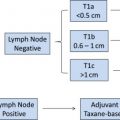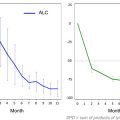First-line endocrine therapy by estrogen antagonism or suppression of estrogen achieves objective responses (ORs) and clinical benefit (CB) in around 30% and 50% of estrogen receptor-positive metastatic breast cancer patients, respectively. Aromatase inhibitors (AIs) are the most effective treatment in previously untreated postmenopausal women. Tamoxifen is an effective alternative. The optimal endocrine therapy on relapse remains uncertain. Tamoxifen and fulvestrant achieve CB in around 50% of patients and ORs of 10%. CB of exemestane after nonsteroidal AIs is 30% to 50% but ORs are rare. Targeted agents (eg, everolimus) plus endocrine therapy are likely to become increasingly important in overcoming endocrine resistance.
Key points
- •
Estrogen receptor–positive metastatic breast cancer is still incurable but responses can be achieved with first-line endocrine therapies in around 30% and clinical benefit (response or stable disease for at least 6 months) in around 50% of patients.
- •
Aromatase inhibitors (AIs) are the most effective treatment in previously untreated postmenopausal women. Tamoxifen is still an effective alternative. Most of these women nowadays have received an adjuvant AI and the optimal endocrine therapy on relapse is uncertain.
- •
Tamoxifen and fulvestrant both achieve clinical benefit in around 50% of such patients, although objective responses are uncommon (around 10%). Exemestane after a nonsteroidal AI can also achieve clinical benefit in 30% to 50% of patients but objective responses are rare.
- •
In premenopausal women, tamoxifen is the treatment of choice if no previous endocrine therapy has been used (and there is some evidence that response rates may be increased with the addition of a luteinizing hormone–releasing hormone [LHRH] analogue) but this situation is now rare. Otherwise, a combination of an AI and an LHRH analogue is indicated. An AI should not be used alone in premenopausal women.
- •
Combined endocrine therapy and targeted therapies to overcome endocrine resistance are a major theme in current clinical research.
Introduction
Endocrine therapy for metastatic breast cancer (mBC) is the oldest effective medical treatment in cancer medicine. As long ago as 1896, Beatson described clinical improvement after oophorectomy in young women affected by breast cancer, although many decades elapsed before the underlying endocrine mechanism was understood. High-dose estrogens were reported as initial treatment of large primary breast cancers in the 1950s and were widely used for many years, despite their significant toxicities.
Surgical adrenalectomy with cortisone substitution was first described to treat advanced breast cancer in 1952 and became a standard form of so-called major ablative surgery for decades as second-line treatment after oophorectomy or in postmenopausal patients; it was effective in selected cases but required specialist skills, intensive support in the immediate postoperative period, and long-term steroid supplementation. Hypophysectomy also had a role as second-line therapy in selected centers.
Two major developments ushered in the modern era of endocrine therapy for mBC. The first was the development of the antiestrogen, tamoxifen, which rapidly established itself as an effective treatment without the significant side effects of estrogens.
The second was the discovery of the estrogen receptor (ER) in the 1960s by Jensen, followed by the investigations by McGuire and colleagues, which established this molecule as the first effective tumor marker for predicting response to endocrine therapy. It is now well established that the chance of response to any type of endocrine therapy is determined by whether or not the tumor is positive for ER and/or progesterone receptors (PgR).
Not all ER-positive breast cancers respond to endocrine therapy. Some seem resistant from the start (de novo resistance) and many acquire resistance during the natural history of the disease, despite continuing to express ER. Overcoming endocrine resistance in ER-positive cancers is one of the great current challenges in breast cancer treatment (discussed later).
Introduction
Endocrine therapy for metastatic breast cancer (mBC) is the oldest effective medical treatment in cancer medicine. As long ago as 1896, Beatson described clinical improvement after oophorectomy in young women affected by breast cancer, although many decades elapsed before the underlying endocrine mechanism was understood. High-dose estrogens were reported as initial treatment of large primary breast cancers in the 1950s and were widely used for many years, despite their significant toxicities.
Surgical adrenalectomy with cortisone substitution was first described to treat advanced breast cancer in 1952 and became a standard form of so-called major ablative surgery for decades as second-line treatment after oophorectomy or in postmenopausal patients; it was effective in selected cases but required specialist skills, intensive support in the immediate postoperative period, and long-term steroid supplementation. Hypophysectomy also had a role as second-line therapy in selected centers.
Two major developments ushered in the modern era of endocrine therapy for mBC. The first was the development of the antiestrogen, tamoxifen, which rapidly established itself as an effective treatment without the significant side effects of estrogens.
The second was the discovery of the estrogen receptor (ER) in the 1960s by Jensen, followed by the investigations by McGuire and colleagues, which established this molecule as the first effective tumor marker for predicting response to endocrine therapy. It is now well established that the chance of response to any type of endocrine therapy is determined by whether or not the tumor is positive for ER and/or progesterone receptors (PgR).
Not all ER-positive breast cancers respond to endocrine therapy. Some seem resistant from the start (de novo resistance) and many acquire resistance during the natural history of the disease, despite continuing to express ER. Overcoming endocrine resistance in ER-positive cancers is one of the great current challenges in breast cancer treatment (discussed later).
Tamoxifen and other endocrine therapies without prior adjuvant aromatase inhibitors
Tamoxifen, the earliest selective ER modulator (SERM) for clinical use, was first described in the treatment of advanced/mBC in 1971 by Cole and colleagues. This new antiestrogen rapidly began to replace high-dose estrogen therapy because of its efficacy and favorable toxicity profile. In a large review of 86 clinical studies involving 5353 patients, an objective response rate (ORR; complete response [CR] + partial response [PR]) of 34% was described with an additional 19% of patients achieving stable disease (SD) for at least 6 months. Median response durations of up to 24 months were reported. Response rates (RRs) tended to increase with age, with a 27% response in those less than 50 years old compared with 43% in those more than 70 years old in a selective review of 60 studies involving 1282 patients in the same publication. Although early studies suggested that responses could be achieved in patients with ER-negative tumors, there is now a strong body of evidence to show that response to tamoxifen and other endocrine therapies occur only in those with ER-positive disease.
Tamoxifen is generally well tolerated with a low incidence of serious side effects except for a low but significantly increased incidence of endometrial cancer and thromboembolic events.
High-dose Estrogens, Progestins, Oophorectomy, and Other SERMs
Tamoxifen was compared with many other endocrine therapies in randomized trials in the early years, and although these were small and lacked statistical power by modern standards it was nevertheless consistently at least as effective or better, and often with a better toxicity profile. These findings include comparisons with high-dose estrogens, megestrol acetate (MA), the most widely used synthetic progestin, and oophorectomy in premenopausal women. Tamoxifen has been shown to be as good as other SERMs, including toremifene and idoxifene, or in some cases better (eg, droloxifene, arzoxifene); all of these were phase II crossover studies showing cross-resistance between tamoxifen and other SERMs.
Aromatase inhibitors
In recent years the third-generation aromatase inhibitors (AIs) letrozole, anastrozole, and exemestane have consistently been shown to be superior to tamoxifen both in advanced/metastatic and in early breast cancer. Unlike tamoxifen they inhibit the synthesis of estrogens from androgens in postmenopausal women (they are ineffective in premenopausal women) and they have transformed endocrine therapy in this large group of women with ER-positive disease.
Second-line Treatment After Tamoxifen
In a first series of randomized control trials (RCTs), each of the third-generation AIs were shown to be superior in efficacy and/or side effects to MA or to the first-generation AI aminoglutethimide as second-line therapy for postmenopausal women progressing on tamoxifen ( Table 1 ).
| Study | Arms | n | ORR (%) | Median TTP or PFS (mo) | Median OS (mo) |
|---|---|---|---|---|---|
| Letrozole vs AG | Letrozole 0.5 mg | 192 | 16.7 | 3.3 | 21 ( P = .04) a |
| Letrozole 2.5 mg | 185 | 19.5 | 3.4 ( P = .008) a | 28 ( P = .002) a | |
| AG 250 mg × 2 | 178 | 12.4 | 3.2 | 20 | |
| Letrozole vs MA | Letrozole 0.5 mg | 188 | 12.8 | 5.1 ( P = .02) | 21.05 ( P = .03) a |
| Letrozole 2.5 mg | 174 | 23.6 ( P = .04) a | 5.6 ( P = .07) | 25.3 | |
| MA 160 mg | 189 | 16.4 | 5.5 | 21.5 | |
| Letrozole vs MA | Letrozole 0.5 mg | 202 | 21 | 6.0 ( P = .044) a | 33 |
| Letrozole 2.5 mg | 199 | 16 | 3.0 | 29 | |
| MA 40 mg × 4 | 201 | 15 | 3.0 | 26 | |
| Anastrozole vs MA | Anastrozole 1 mg | 263 | 12.5 | 4.8 | 26.7 ( P = .025) a |
| Anastrozole 10 mg | 248 | 12.5 | 5.3 | 25.5 | |
| MA 40 mg × 4 | 253 | 12.3 | 4.6 | 22.5 | |
| Exemestane vs MA | Exemestane 25 mg | 366 | 15 | 4.7 ( P = .037) a | — ( P = .039) a |
| MA 40 mg × 4 | 403 | 12.4 | 3.9 | 28.8 |
First-line Treatment Compared with Tamoxifen
Letrozole, anastrozole, and exemestane were subsequently compared with tamoxifen as first-line treatment of postmenopausal women with advanced/mBC. The main trials are summarized in Table 2 .
| Study/Arms | n | ORR (%) | CBR (%) | Median TTP or PFS (mo) | Median OS (mo) |
|---|---|---|---|---|---|
| Anastrozole vs tamoxifen | 171 | 21 | 59 | 11.1 ( P = .005) | 33 |
| 182 | 17 | 46 | 5.6 | 32 | |
| Anastrozole vs tamoxifen | 340 | 33 | 56 | 8.2 | 38 |
| 328 | 33 | 55 | 8.3 | 42 | |
| Letrozole vs tamoxifen | 453 | 32 ( P = .0002) | 50 ( P = .0004) | 9.4 ( P <.0001) | 34 |
| 454 | 21 | 38 | 6.0 | 30 | |
| Exemestane vs tamoxifen | 182 | 46 ( P = .05) | — | 9.9 ( P = .05) | 37 |
| 189 | 31 | — | 5.8 | 43 |
In a North American multicenter RCT, anastrozole was as effective as tamoxifen in terms of ORR (21% vs 17% of patients, respectively) with significant advantage compared with tamoxifen in terms of clinical benefit rate (CBR) (CR + PR + SD ≥24 weeks, 59% vs 46%, respectively; 2-sided P = .0098, retrospective analysis) and time to progression (TTP) (median, 11.1 vs 5.6 months, respectively; 2-sided P = .005). Almost 90% of patients enrolled in this trial were ER positive. A rest-of-the-world study (TARGET [Tamoxifen or Arimidex Randomized Group Efficacy and Tolerability] study) reported equivalence but not superiority of anastrozole compared with tamoxifen, but in this trial only 45% of patients were known to have an ER-positive tumor. The pooled retrospective combined analysis of these two trials, including only the subgroup with ER-positive tumors (60% of combined trial population), showed that anastrozole was significantly superior to tamoxifen with respect to TTP (median values of 10.7 and 6.4 months) but not for overall survival (OS).
In another large trial comparing letrozole with tamoxifen and involving 916 patients, letrozole significantly improved TTP compared with tamoxifen (median 9.4 vs 6.0 months, respectively) but no significant improvement in OS was observed.
Exemestane, a steroidal AI, was compared with tamoxifen in an RCT conducted by the European Organisation for Research and Treatment of Cancer (EORTC) Breast Cancer Cooperative Group. Median progression-free survival (PFS) was longer with exemestane (9.9 months; 95% confidence interval [CI], 8.7–11.8 months) than with tamoxifen (5.8 months), but these early differences (Wilcoxon P = .028) did not translate to a longer-term benefit in PFS, the primary study end point (log-rank P = .121), or OS.
A meta-analysis conducted by Ferretti and colleagues on 6 phase III prospective RCTs including those described earlier and involving 2787 women treated with second-generation or third-generation AI versus tamoxifen confirmed a significant advantage in ORR, TTP, and CBR favoring AIs rather than tamoxifen detected in the fixed-effects model but not in the random-effects model, owing to the significant heterogeneity between studies. In contrast, no difference was found in OS using either model. Tamoxifen was associated with significantly more thromboembolic events and vaginal bleeding than the AIs. Hot flushes, vomiting, and musculoskeletal pain were slightly more frequent in the AI than the tamoxifen group but without reaching statistical significance.
These trials were not always conducted with the academic rigor to be expected in large modern trials, but the weight of evidence from these consistently argued in favor of the AIs having small but significant efficacy advantages compared with tamoxifen.
The era of adjuvant AIs
In the last 10 years the AIs letrozole, anastrozole, and exemestane have largely replaced tamoxifen as adjuvant treatment of early breast cancer in postmenopausal women, based on a series of large adjuvant trials showing their superior efficacy.
This means that much of the evidence described earlier has become redundant, given that most postmenopausal women with metastatic ER-positive breast cancer have already relapsed on or after an adjuvant AI, and there is now uncertainty about optimal further endocrine therapy in these circumstances. Several further options are available.
Tamoxifen After AIs
There are limited data about the efficacy of tamoxifen after AI failure. Retrospective crossover data for tamoxifen treatment are available from the North American and TARGET trials described earlier comparing the efficacy of tamoxifen following anastrozole with anastrozole following tamoxifen as first-line treatment of postmenopausal patients with mBC. Of the 511 patients who were initially randomized to anastrozole, 137 (26.8%) received tamoxifen as second-line therapy at crossover. Among them, 40 had intervening chemotherapy and/or other hormonal therapy and therefore tamoxifen was technically third line. Overall clinical response data were available for 119 patients, with an ORR of 10.1% (12/119) and a CBR of 48.7% (58/119). Results for patients crossing directly to tamoxifen, without intervening therapy, were similar to those for all patients. ORR and CBR were 13.3% (6/45) and 48.9% (22/45) respectively in patients with visceral metastases, compared with ORR and CBR of 8.2% (6/73) and 49.3% (36/73) respectively for nonvisceral disease.
A second source of data is the TAMRAD (Tamoxifen-RAD001 vs Tamoxifen Alone in Patients With Anti-aromatase Resistant Breast Metastatic Cancer) trial, discussed further later. In this phase 2 trial, postmenopausal women with ER-positive human epidermal growth factor receptor (HER) 2–negative mBC resistant to an AI were randomized to treatment with tamoxifen in combination with the mammalian target of rapamycin (mTOR) inhibitor everolimus (n = 54) or tamoxifen alone (n = 57). Patients in the tamoxifen-alone arm had an ORR of 13%, a CBR of 42%, a median TTP of 4.5 months, and a median OS of 32.9 months.
These data show that tamoxifen is of clinical benefit (CB) in almost 50% of patients relapsing on or after an AI, but only 10% or less achieve an objective response.
Exemestane After Nonsteroidal AIs
AIs can be divided into 2 classes, with different structures and mechanisms of action on the aromatase receptor site. Letrozole and anastrozole are in the first category. These AIs have a nonsteroidal structure and bind reversibly to the active site of the aromatase enzyme. In contrast, exemestane has a steroidal structure and binds irreversibly to the active site. So far there is little evidence that these differences have any major clinical relevance, although there is some suggestion of a lack of complete clinical cross-resistance.
A phase II study evaluated exemestane in 241 patients who had progressed after treatment with a nonsteroidal AI (NSAI). A clinical CR was observed in 3 (1.2%) patients, and PR in 13 (5.4%), giving an ORR of 6.6%. SD for at least 6 months was seen in 101 (41.9%) patients, and the median TTP was 14.7 months.
Lack of cross-resistance between exemestane and NSAIs was also observed in an open-label, exploratory clinical trial comparing sequential treatment with exemestane and NSAIs in mBC. In this study, exemestane (n = 23) showed activity in patients after relapse or lack of response to letrozole or anastrozole with an ORR of 8.7%, a CBR of 43.5%, a median TTP of 5.1 months, and a median OS of 27.2 months. Likewise letrozole (n = 17) and anastrozole (n = 1) (total n = 18) had clinical activity after failure on exemestane with an ORR of 22.2%, a CBR of 55.6%, a median TTP of 9.3 months, and a median OS of 29.7 months.
Two trials have compared exemestane with the steroidal antiestrogen fulvestrant in patients no longer responding to an NSAI. In the first, EFECT (Evaluation of the Efficacy and Tolerability of Faslodex[Fulvestrant] and Aromasin[Exemestane] in Hormone Receptor Positive Postmenopausal Women With Advanced Breast Cancer), involving 693 postmenopausal patients with ER-positive mBC, the median TTP was 3.7 months for both arms and CBR was also similar in patients treated with exemestane (31.5% for exemestane and 32.2% for fulvestrant given in a dose of 500 mg on day 0, and 250 mg on days 14 and 28 and every 28 days thereafter).
The second was the SoFEA (Fulvestrant With or Without Anastrozole or Exemestane Alone in Treating Postmenopausal Women With Locally Advanced or Metastatic Breast Cancer) trial, a multicenter, randomized, partially blinded phase III study designed to investigate fulvestrant alone (n = 231) or with concomitant anastrozole (n = 243) versus exemestane (n = 249) following progression on NSAI. Inclusion criteria included response to a previous NSAI in locally advanced/metastatic disease for more than 6 months (82%) or as adjuvant therapy for more than 12 months (18%). The median PFS was 4.4, 4.8, and 3.4 months for fulvestrant plus anastrozole, fulvestrant alone, and exemestane, respectively. A longer PFS was positively correlated with duration of prior AI exposure but no interaction with treatment was observed. No difference was found in ORR, CBR, or OS. The 249 patients treated with exemestane had an ORR and CBR of 2.8% and 39.8%, respectively.
Fulvestrant
The selective ER downregulator fulvestrant is a pure antiestrogen that binds to ER, inducing a conformational change that disrupts ER transcriptional activity and accelerates ER degradation. These features are unique to this agent. Initial clinical studies showed that fulvestrant 250 mg monthly by intramuscular (IM) injection (approved dose [AD]) had similar first-line efficacy to tamoxifen, with a median TTP of 6.8 and 8.3 months respectively (hazard ratio [HR], 1.18; 95% CI, 0.98–1.44; P = .088) and ORRs of 31.6% and 33.9% respectively.
Fulvestrant 250 mg was likewise similar to anastrozole in 400 patients whose disease had progressed on adjuvant endocrine therapy with an antiestrogen or whose disease had progressed after first-line endocrine therapy for advanced disease. Median TTP was 5.4 months with fulvestrant (n = 206) versus 3.4 months with anastrozole (n = 194) (HR, 0.92; 95% CI, 0.74–1.14; P = .43) and ORR was 17.5% in both arms. This trial was prospectively designed to be combined with a second study with similar design and the combined analysis of data at a median follow-up of 15.1 months showed that fulvestrant was at least as effective as anastrozole in terms of median TTP (5.5 months vs 4.1 months, respectively) and OR (19% vs 17%, respectively). In a subsequent survival analysis after a median follow-up of 27 months there was no significant difference in the median time to death between fulvestrant and anastrozole (27.4 months vs 27.7 months, respectively).
As discussed earlier, the EFECT trial showed that AD fulvestrant (500 mg on day 0, 250 mg on days 14 and 28, and 250 mg every 28 days thereafter) had similar modest efficacy to exemestane after NSAI failure.
Subsequent studies suggested that the AD of fulvestrant was likely not to be the optimal dose for this agent and several trials tested different doses. These trials are summarized in Table 3 .
| Study/Arms | n | ORR (%) | CBR (%) | Median TTP or PFS (mo) | Median OS (mo) |
|---|---|---|---|---|---|
| First Line | |||||
| Fulv 250 mg monthly vs tamoxifen | 313 | 31.6 | 54.3 | 6.8 | 36.9 |
| 274 | 33.9 | 62 | 8.3 | 38.7 | |
| Fulv 250 mg monthly vs anastrozole | 206 | 17.5 | 42.2 | 5.4 | — |
| 194 | 17.5 | 36.1 | 3.4 | — | |
| Fulv 250 mg monthly vs anastrozole | 222 | 20.7 | 44.6 | 5.5 | — |
| 229 | 15.7 | 45.0 | 5.1 | — | |
| Fulv LD + anastrozole vs anastrozole | 258 | 31.8 | 55.0 | 10.8 | 37.8 |
| 256 | 33.6 | 55.1 | 10.2 | 38.2 | |
| Fulv LD + anastrozole vs anastrozole | 355 | — | — | 15 ( P <.007) | 47.7 ( P = .049) |
| 352 | — | — | 13.5 | 41.3 | |
| Fulv HD vs anastrozole | 102 | 36.0 | 72.5 | 23.4 ( P = .01) | — |
| 103 | 35.5 | 67.0 | 13.1 | — | |
| Study | Arms | n | ORR (%) | Median TTP or PFS (mo) | Median OS (mo) |
|---|---|---|---|---|---|
| Second Line or Beyond | |||||
| CONFIRM (second line) phase III | Fulv HD vs | 362 | 9.1 | 6.5 ( P = .006) | 25.2 |
| Fulv 250 mg monthly | 374 | 10.2 | 5.5 | 22.8 | |
| EFECT (third line or more) phase III | Fulv LD vs | 351 | 7.4 | 3.7 | NR |
| Exemestane | 342 | 6.7 | 3.7 | NR | |
| SOFEA (acquired AI resistance) phase III | Fulv LD + anastrozole vs | 243 | 7.4 | 4.4 | 20.2 |
| Fulv LD vs | 231 | 6.9 | 4.8 | 19.4 | |
| Exemestane | 249 | 3.6 | 3.4 | 21.6 | |
Stay updated, free articles. Join our Telegram channel

Full access? Get Clinical Tree







